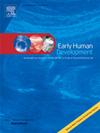全球儿童期和青春期早产儿相关发育性智力残疾的患病率和致残率
IF 2.2
3区 医学
Q2 OBSTETRICS & GYNECOLOGY
引用次数: 0
摘要
目的综合评价1990 ~ 2021年早产儿(CABP)中早产儿相关发育性智力障碍(PDID)的患病率和残疾生活年限(YLDs)。方法利用《2021年全球疾病负担》的数据,通过联结点回归、年龄-时期-队列(A-P-C)分析和跨国健康不平等分析,对全球、地区和国家层面CABP(0-19岁)患者PDID负担进行评估。结果2021年全球CABP患者PDID患病率为12114153例,YLDs为915937例,男性高于女性。此外,从1990年到2021年,世界范围内只有年龄标准化患病率略有下降,严重病例比例略有增加,流行病例和死亡人数呈显著上升趋势。年龄亚组分析显示,5岁儿童PDID负担显著减轻。A-P-C分析发现,与中高社会人口指数(SDI)地区相比,PDID的风险在5岁儿童中最高,而低SDI地区的时期和队列效应不利。跨国卫生不平等分析结果显示,CABP中PDID负担集中在低sdi国家,而sdi相关不平等在1990年至2021年间普遍下降。总体而言,从1990年到2021年,全球CABP患者的PDID负担有所增加,而全球5岁以下儿童的PDID负担有所下降。尽管卫生不平等现象有所减少,但低sdi地区仍然承担着沉重的负担。本文章由计算机程序翻译,如有差异,请以英文原文为准。
Worldwide prevalence and disability from preterm-associated developmental intellectual disability during childhood and adolescence
Objective
To comprehensively assess the prevalence and years lived with disability (YLDs) of preterm-associated developmental intellectual disability (PDID) in children and adolescents born preterm (CABP) from 1990 to 2021.
Method
Using data from the Global Burden of Disease 2021, the burden of PDID in CABP (0–19 years) at global, regional and national levels was assessed by joinpoint regression, age-period-cohort (A-P-C) analysis, and cross-country health inequality analysis.
Results
Globally, there were 12,114,153 prevalent cases and 915,937 YLDs of PDID in CABP in 2021, with much higher values in males than in females. Moreover, the prevalent cases and YLDs demonstrated significant increasing trends, whereas only the age-standardized rate of prevalence showed a slight decline from 1990 to 2021 worldwide, with a slight increase in the proportion of severe cases. The age subgroup analysis showed a significant reduction in the burden of PDID in children aged <5 years. The A-P-C analysis found that, in contrast to middle to high-sociodemographic index (SDI) regions, the risk of PDID was highest in children aged <5 years, and that period and cohort effects were unfavourable in low-SDI regions. The results of cross-country health inequality analysis showed that the burden of PDID in CABP was concentrated in low-SDI countries, while SDI-related inequalities generally decreased between 1990 and 2021.
Conclusion
Overall, the global burden of PDID in CABP has increased from 1990 to 2021, while the burden in children under 5 years of age has decreased globally. Despite reduced health inequalities, low-SDI regions still bear a significant burden.
求助全文
通过发布文献求助,成功后即可免费获取论文全文。
去求助
来源期刊

Early human development
医学-妇产科学
CiteScore
4.40
自引率
4.00%
发文量
100
审稿时长
46 days
期刊介绍:
Established as an authoritative, highly cited voice on early human development, Early Human Development provides a unique opportunity for researchers and clinicians to bridge the communication gap between disciplines. Creating a forum for the productive exchange of ideas concerning early human growth and development, the journal publishes original research and clinical papers with particular emphasis on the continuum between fetal life and the perinatal period; aspects of postnatal growth influenced by early events; and the safeguarding of the quality of human survival.
The first comprehensive and interdisciplinary journal in this area of growing importance, Early Human Development offers pertinent contributions to the following subject areas:
Fetology; perinatology; pediatrics; growth and development; obstetrics; reproduction and fertility; epidemiology; behavioural sciences; nutrition and metabolism; teratology; neurology; brain biology; developmental psychology and screening.
 求助内容:
求助内容: 应助结果提醒方式:
应助结果提醒方式:


